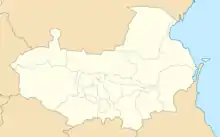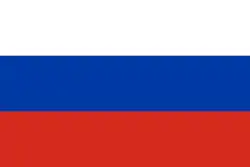Terek Oblast
The Terek Oblast (Russian: Терская область) was an oblast (province) of the Caucasus Viceroyalty of the Russian Empire, roughly corresponding to the central part of Russia's North Caucasian Federal District. With its administrative center in Vladikavkaz, the contemporary capital of North-Ossetia-Alania within the Russian Federation, the Terek Oblast was originally created out of the former territories of the North Caucasian Peoples, following their conquests by Russia throughout the 19th century. The Terek Oblast bordered the Astrakhan and Stavropol governorates to the north, the Kuban Oblast to the west, the Kutais and Tiflis governorates to the south, and the Dagestan Oblast to the east.
Terek Oblast
Терская область | |
|---|---|
 Coat of arms | |
 Administrative map of the Terek Oblast | |
| Country | Russian Empire |
| Viceroyalty | Caucasus |
| Established | 1873 |
| Abolished | 1917 |
| Capital | Vladikavkaz |
| Area | |
| • Total | 69,271 km2 (26,746 sq mi) |
| Highest elevation (Elbrus) | 5,642 m (18,510 ft) |
| Population (1916) | |
| • Total | 1,377,923 |
| • Density | 20/km2 (52/sq mi) |
| • Urban | 17.50% |
| • Rural | 82.50% |
Administrative divisions
In 1862, the Terek Oblast consisted of 8 okrugs (districts):
- Kabardian Okrug
- Ossetian Okrug
- Ingush Okrug
- Argun Okrug
- Chechen Okrug
- Ichkerian Okrug
- Kumyk Okrug
- Nagorny Okrug
By 1917, the Terek Oblast consisted of 6 okrugs (districts), 4 otdels (Cossack districts), and one pristavstvo:
- Vedeno Okrug
- Vladikavkaz Okrug
- Grozny Okrug
- Nazran Okrug
- Nalchik Okrug
- Kizlyar Otdel
- Mozdok Otdel
- Pyatigorsk Otdel
- Sunzha Otdel
- Khasavyurt Okrug
- Kara-Nogai Pristavstvo (transferred from Stavropol Governorate in 1888)
Demographics
As of 1897, 933,936 people populated the oblast. Russians constituted a plurality of the population. Significant minorities consisted of Chechens, Ossetians, Kabardians, Ingush, Nogais, Kumyks and Tatars.
Russian Imperial Census of 1897[1]
| Russians | 271,185 | 29% |
| Chechens | 223,347 | 23.9% |
| Ossetians | 96,621 | 10.3% |
| Kabardians | 84,093 | 9% |
| Ingush | 47,184 | 5.1% |
| Nogais | 36,577 | 3.9% |
| Kumyks | 31,826 | 3.4% |
| Tatars | 27,370 | 2.9% |
| Armenians | 11,803 | 1.3% |
| TOTAL | 933,936 | 100% |
|---|
Caucasian Calendar of 1917
The 1917 Caucasian Calendar which produced statistics of 1916 indicates 1,377,923 residents in the Terek Oblast, including 722,685 men and 655,238 women, 1,113,608 of whom were the permanent population, and 264,315 were temporary residents.[2]
| Okrug/Otdel (district) | Russians | Other Europeans | Georgians | Armenians | North Caucasians | Other Asian Nationalities | Gypsies | Jews | TOTAL | |||
|---|---|---|---|---|---|---|---|---|---|---|---|---|
| Orthodox | Sectarian | Christian | Shia Muslim | Sunni Muslim | ||||||||
| Vedeno | 307 | 0 | 7 | 6 | 13 | 127,048 | 0 | 26 | 311 | 0 | 0 | 127,718 |
| 0.2% | 0.0% | 0.0% | 0.0% | 0.0% | 99.5% | 0.0% | 0.0% | 0.2% | 0.0% | 0.0% | 100.0% | |
| Vladikavkaz | 37,463 | 11,325 | 7,360 | 1,674 | 8,386 | 138,171 | 0 | 2,463 | 0 | 102 | 798 | 207,742 |
| 18.0% | 5.5% | 3.5% | 0.8% | 4.0% | 66.5% | 0.0% | 1.2% | 0.0% | 0.0% | 0.4% | 100.0% | |
| Grozny | 56,891 | 884 | 1,918 | 0 | 1,844 | 133,080 | 0 | 0 | 0 | 0 | 1,127 | 195,744 |
| 29.1% | 0.5% | 1.0% | 0.0% | 0.9% | 68.0% | 0.0% | 0.0% | 0.0% | 0.0% | 0.6% | 100.0% | |
| Nazran | 197 | 7 | 0 | 0 | 0 | 58,842 | 0 | 0 | 0 | 0 | 0 | 59,046 |
| 0.3% | 0.0% | 0.0% | 0.0% | 0.0% | 99.7% | 0.0% | 0.0% | 0.0% | 0.0% | 0.0% | 100.0% | |
| Nalchik | 36,060 | 1,750 | 5,299 | 0 | 350 | 134,390 | 0 | 0 | 0 | 1,660 | 1,025 | 180,534 |
| 20.0% | 1.0% | 2.9% | 0.0% | 0.2% | 74.4% | 0.0% | 0.0% | 0.0% | 0.9% | 0.6% | 100.0% | |
| Kizlyar | 92,956 | 340 | 353 | 1,184 | 7,201 | 2,417 | 0 | 3,432 | 28,294 | 0 | 572 | 136,749 |
| 68.0% | 0.2% | 0.3% | 0.9% | 5.3% | 1.8% | 0.0% | 2.5% | 20.7% | 0.0% | 0.4% | 100.0% | |
| Mozdok | 75,910 | 4,725 | 4,225 | 50 | 8,410 | 13,895 | 350 | 0 | 65 | 15 | 100 | 107,745 |
| 70.5% | 4.4% | 3.9% | 0.0% | 7.8% | 12.9% | 0.3% | 0.0% | 0.1% | 0.0% | 0.1% | 100.0% | |
| Pyatigorsk | 174,980 | 7,380 | 10,921 | 862 | 4,001 | 1,633 | 8 | 236 | 31 | 109 | 325 | 200,486 |
| 87.3% | 3.7% | 5.4% | 0.4% | 2.0% | 0.8% | 0.0% | 0.1% | 0.0% | 0.1% | 0.2% | 100.0% | |
| Sunzha | 72,276 | 1,731 | 62 | 185 | 138 | 87 | 0 | 0 | 26 | 0 | 0 | 74,505 |
| 97.0% | 2.3% | 0.1% | 0.2% | 0.2% | 0.1% | 0.0% | 0.0% | 0.0% | 0.0% | 0.0% | 100.0% | |
| Khasavyurt | 16,711 | 1,148 | 6,155 | 0 | 87 | 61,640 | 0 | 0 | 0 | 0 | 1,913 | 87,654 |
| 19.1% | 1.3% | 7.0% | 0.0% | 0.1% | 70.3% | 0.0% | 0.0% | 0.0% | 0.0% | 2.2% | 100.0% | |
| TOTAL | 563,751 | 29,290 | 36,300 | 3,961 | 30,430 | 671,203 | 358 | 6,157 | 28,727 | 1,886 | 5,860 | 1,377,923 |
| 40.9% | 2.1% | 2.6% | 0.3% | 2.2% | 48.7% | 0.0% | 0.4% | 2.1% | 0.1% | 0.4% | 100.0% | |
References
- "Демоскоп Weekly – Приложение. Справочник статистических показателей". www.demoscope.ru.
- Кавказский календарь .... на 1917 год (in Russian). Tiflis: Office of the Viceroy of the Caucasus. 1917. pp. 373–378.
